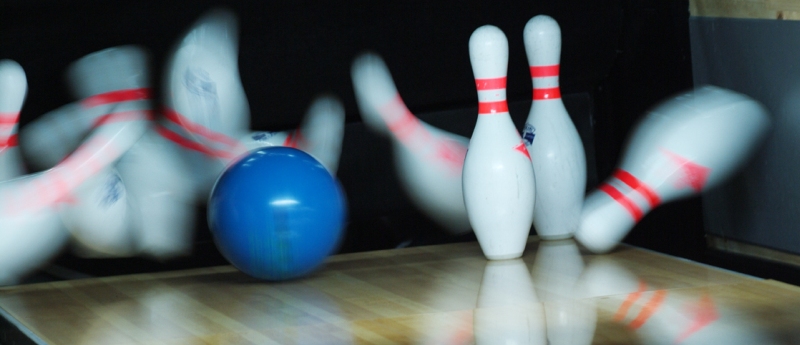
We all know that bowling lanes have oil on them and that the oil dries out as time goes by and many games are bowled on them but do bowling balls absorb oil from a bowling lane or do they just move the oil around making the lane feel drier?
The short answer to this questions is yes, all bowling balls absorb oil into their coverstocks but some types of balls absorb more than others.
As a general rule of thumb modern plastic or polyurethane balls are the least absorbent coverstocks used in modern bowling followed in order of porosity by urethane, pearl reactives, hybrid reactives, and finally solid reactive balls.
Do Plastic Balls Absorb Lane Oil?
Plastic spare balls for instance will absorb almost no oil at all. Imagine trying to absorb oil with a plastic bag… not going to happen.
Instead the plastic ball will pickup oil from the heads or mid-lane and deposit it in thin streaks further down the lane where it is dry.
This is what bowlers refer to as “carry-down”.
Are Urethane Balls Porous?
Urethane balls are similar to plastic balls because they contribute more to carry down then they do to oil absorption.
When you throw a urethane ball down a lane the oil rings found on the track of the ball will absorb into the ball but in very small amounts.
A generation ago (let’s say the 80’s) before modern reactive bowling balls hit the market in sufficient quantity most bowlers threw plastic and/or urethane balls, hard rubber even if the ball was particularly old.
At that time carry down (or oil migration) was a much bigger and important topic than it is today.
Oil was placed heavy on the lanes in the heads (the first 15 feet or so) and the oil tapered to the back-end of the lane steeply because bowling balls were expected to move the oil down the lane little by little with every throw.
Modern reactives however have changed things dramatically.
How Much Oil Do Reactive Bowling Balls Absorb From A Bowling Lane?
These days you can easily sort the reactive style balls into three buckets:
- Solids
- Pearls
- Hybrids
Reactive Solid Balls
Categorically speaking, a solid coverstock will absorb the most oil of all types of covers although there may be individual balls that are outliers which don’t adhere to the general rule of thumb.
Solid covers usually have deep peaks and valleys on their surfaces at the microscopic level. These act kind of like tire treads providing traction when the ball encounters friction on the lane.
These balls not only quickly read the friction at the end of a pattern but many of them can even react to small amounts of friction that they encounter in the mid-lane where there is still a thin film of oil applied.
When the tread lines are deep enough, as they are on a solid reactive bowling ball, the coverstock will react to any friction found on an oiled lane faster and more aggressively than all other types of covers.
The oil these balls cut through doesn’t just splash to the sides of a ball while it spins down the lane.
Because the oil film is so thin it adheres to the coverstock as the ball rolls over it and then it pools in the tiny valleys found on the ball at the microscopic level before slowly absorbing into the shell.
Much of the oil that accumulates in these troughs can be wiped off easily with a towel before it absorbs in the the cover but over time the cover will start to saturate even if you regularly wipe it down after each shot and even if you use a surface cleaner after each bowling session.
Basically a solid reactive ball will absorb lane oil more easily and in greater volumes than any other cover style.
A brand new solid reactive ball (or a resurfaced solid ball) will absorb oil even faster than an older ball would because an older ball will already have some of it’s pores saturated or clogged with grime that may be invisible to the naked eye.
More – How to Break Down an Oil Pattern Fast With a Solid Reactive Ball
Reactive Pearlized Balls
A reactive pearlized ball is similar to a solid except the cover is less able to cut through the oil film found on a lane.
The Pearized ball will skid over this oil further down lane reserving more of it’s energy for the end of the pattern where there is less or no oil on the lane. This is where the ball reacts to friction aggressively.
The pearlized shell will absorb more oil from a lane than a plastic or urethane ball because it still is made from a porous resin and because it still has those peaks and troughs that can hold onto more oil easily but they will generally absorb less oil than a ball with a solid reactive coverstock.
Reactive Hybrid Balls
As you would expect a hybrid ball marry’s the coverstock elements of both the pearl and the solid to land somewhere in between.
It will absorb oil more easily than the pearl and less so than the solid and it will react to lane conditions in between as well.
You can generally expect a hybrid shell to react to small amounts of friction in the mid-lane like a solid but still reserve the bulk of it’s energy for the end of the pattern when significant friction is found at the break point just like a pearlized ball would.
Do Reactive Balls Contribute to Carry Down?
As a rule of thumb, most reactive balls will not streak significant amounts of oil down the lane like plastic or urethane balls do.
Instead they will flare as they roll down the lane picking up oil from all parts of the lane along the track line. The balls will then slowly absorb the oil into the coverstock thereby removing it completely from the lane surface.
This is why modern lane adjustments for high-tech bowling balls usually dictate a movement of the feet and target to the left as the lanes dry out instead of a move to the right in the case of significant carry-down related oil migration.
This is also means that a new reactive bowling ball’s coverstock will slowly saturate with oil with every passing game. Just like a paper towel will slowly saturate with water if you keep using it to dry dish after dish at the sink.
Does Oil Absorption Harm a Bowling Ball?
Reactive bowling balls will work just fine if you never extract the oil from the coverstock but they wont react quite so strong, they won’t react the way they did when they were brand new.
Some people swear by regular cleaning and de-oiling of their balls and they periodically do a deep clean and resurfacing of their balls to extend their out-of-box feel for as long as possible while other bowlers do the opposite.
For years I’ve been the bowler that buys a ball and uses it for hundreds of games without ever taking the time to clean them. Once a ball saturates it’s just not going to absorb any more oil.
Just like a paper towel will dry a dish, once the towel is saturated it just won’t dry the dish very well until it is rung out.
Can A Bowling Ball Fully Saturate With Lane Oil?
With a bowling ball it can take hundreds of games to fully saturate… possibly thousands!
This is why balls that are many years old can still dry out a lane on any given league night or tournament squad.
If however a ball is regularly maintained, cleaned, and de-oiled, the ball will absorb more oil per game and will subsequently dry a lane out faster that one that is already heavily saturated and not previously bled of oil.
The next main topic that I will address on another article is whether or not you should regularly deep clean your bowling ball.
Should You Remove The Oil From Your Bowling Ball.
There are pros, cons, and even risks to doing it which are worth taking the time to fully understand.
